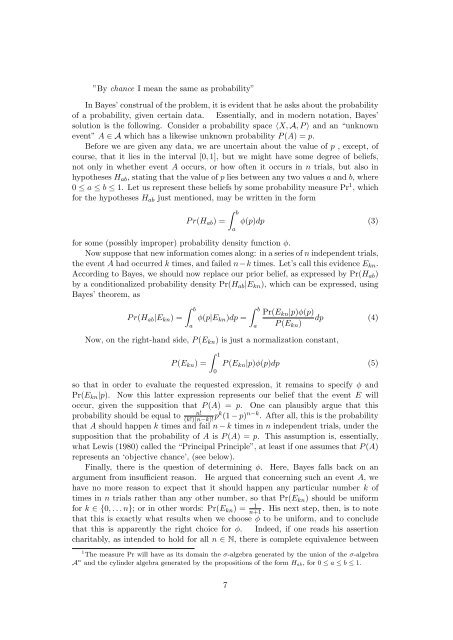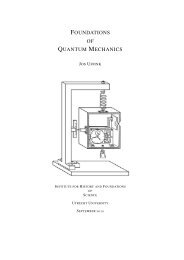Subjective probability and statistical physics
Subjective probability and statistical physics
Subjective probability and statistical physics
You also want an ePaper? Increase the reach of your titles
YUMPU automatically turns print PDFs into web optimized ePapers that Google loves.
”By chance I mean the same as <strong>probability</strong>”<br />
In Bayes’ construal of the problem, it is evident that he asks about the <strong>probability</strong><br />
of a <strong>probability</strong>, given certain data. Essentially, <strong>and</strong> in modern notation, Bayes’<br />
solution is the following. Consider a <strong>probability</strong> space 〈X, A, P 〉 <strong>and</strong> an “unknown<br />
event” A ∈ A which has a likewise unknown <strong>probability</strong> P (A) = p.<br />
Before we are given any data, we are uncertain about the value of p , except, of<br />
course, that it lies in the interval [0, 1], but we might have some degree of beliefs,<br />
not only in whether event A occurs, or how often it occurs in n trials, but also in<br />
hypotheses H ab , stating that the value of p lies between any two values a <strong>and</strong> b, where<br />
0 ≤ a ≤ b ≤ 1. Let us represent these beliefs by some <strong>probability</strong> measure Pr 1 , which<br />
for the hypotheses H ab just mentioned, may be written in the form<br />
P r(H ab ) =<br />
∫ b<br />
a<br />
φ(p)dp (3)<br />
for some (possibly improper) <strong>probability</strong> density function φ.<br />
Now suppose that new information comes along: in a series of n independent trials,<br />
the event A had occurred k times, <strong>and</strong> failed n−k times. Let’s call this evidence E kn .<br />
According to Bayes, we should now replace our prior belief, as expressed by Pr(H ab )<br />
by a conditionalized <strong>probability</strong> density Pr(H ab |E kn ), which can be expressed, using<br />
Bayes’ theorem, as<br />
P r(H ab |E kn ) =<br />
∫ b<br />
a<br />
φ(p|E kn )dp =<br />
∫ b<br />
a<br />
Pr(E kn |p)φ(p)<br />
dp (4)<br />
P (E kn )<br />
Now, on the right-h<strong>and</strong> side, P (E kn ) is just a normalization constant,<br />
P (E kn ) =<br />
∫ 1<br />
0<br />
P (E kn |p)φ(p)dp (5)<br />
so that in order to evaluate the requested expression, it remains to specify φ <strong>and</strong><br />
Pr(E kn |p). Now this latter expression represents our belief that the event E will<br />
occur, given the supposition that P (A) = p. One can plausibly argue that this<br />
n!<br />
<strong>probability</strong> should be equal to<br />
(k!)(n−k)! pk (1 − p) n−k . After all, this is the <strong>probability</strong><br />
that A should happen k times <strong>and</strong> fail n − k times in n independent trials, under the<br />
supposition that the <strong>probability</strong> of A is P (A) = p. This assumption is, essentially,<br />
what Lewis (1980) called the “Principal Principle”, at least if one assumes that P (A)<br />
represents an ‘objective chance’, (see below).<br />
Finally, there is the question of determining φ. Here, Bayes falls back on an<br />
argument from insufficient reason. He argued that concerning such an event A, we<br />
have no more reason to expect that it should happen any particular number k of<br />
times in n trials rather than any other number, so that Pr(E kn ) should be uniform<br />
for k ∈ {0, . . . n}; or in other words: Pr(E kn ) = 1<br />
n+1<br />
. His next step, then, is to note<br />
that this is exactly what results when we choose φ to be uniform, <strong>and</strong> to conclude<br />
that this is apparently the right choice for φ. Indeed, if one reads his assertion<br />
charitably, as intended to hold for all n ∈ N, there is complete equivalence between<br />
1 The measure Pr will have as its domain the σ-algebra generated by the union of the σ-algebra<br />
A n <strong>and</strong> the cylinder algebra generated by the propositions of the form H ab , for 0 ≤ a ≤ b ≤ 1.<br />
7
















